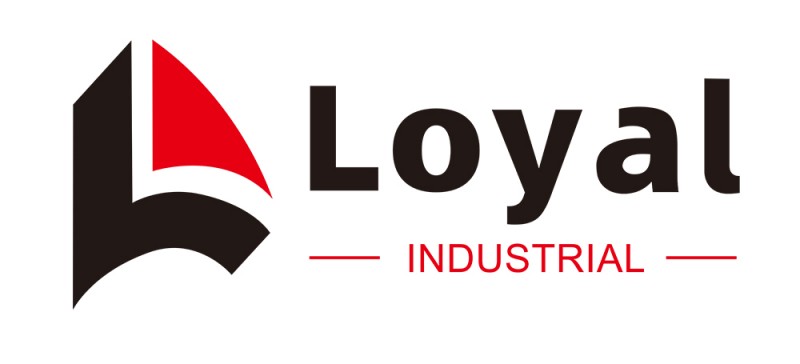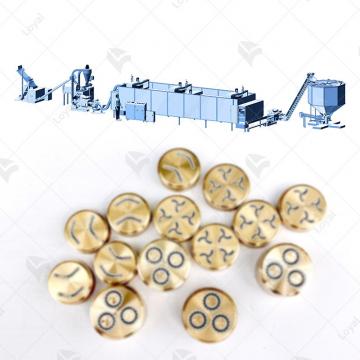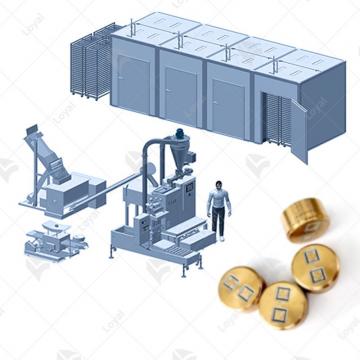Achieving Peak Efficiency with Fully Automatic Manufacturing Shortcut Technology in Pasta Production
Achieving Peak Efficiency with Fully Automatic Manufacturing Shortcut Technology in Pasta Production
Combined pasta machine have revolutionized the landscape of pasta production, and the integration of Fully Automatic Manufacturing Shortcut Technology has propelled the industry to new heights of efficiency. In this exploration, we delve into the definition of this cutting-edge technology, emphasizing its significance in achieving peak efficiency within the realm of pasta production. Additionally, we provide an overview of the pivotal role technology plays in modern manufacturing.Shandong Loyal Industrial Co., Ltd. has incorporated advanced technologies from Tecalit and SARP in the production of its macaroni.
Fully Automatic Manufacturing Shortcut Technology refers to a sophisticated approach that streamlines various aspects of pasta production. It involves the seamless integration of automated processes, enhancing the overall efficiency and output of pasta manufacturing. The significance of achieving peak efficiency in this context cannot be overstated, as it directly impacts production costs, quality, and competitiveness in the market. As we navigate through this article, we will uncover the intricate details of this technology and its transformative effects on the pasta production landscape.

Understanding Manufacturing Shortcuts
To comprehend the impact of Fully Automatic Manufacturing Shortcut Technology, it's crucial to understand the broader concept of manufacturing shortcuts in the context of pasta production. We will explore the benefits and drawbacks associated with implementing manufacturing shortcuts, drawing insights from successful case studies in other industries. By doing so, we aim to provide a comprehensive understanding of the strategic importance of adopting such shortcuts in the food machinery sector.
Manufacturing shortcuts are strategic approaches that aim to optimize processes without compromising quality. In the realm of pasta production, these shortcuts can lead to significant improvements in production speed, resource utilization, and overall operational efficiency. Through a careful examination of successful applications in diverse industries, we can draw parallels and glean valuable insights for the pasta manufacturing domain.
Fully Automatic Manufacturing in Pasta Production
Moving deeper into the heart of our exploration, we will provide a detailed explanation of Fully Automatic Manufacturing in the pasta industry. This section will unveil the key features and components of the technology, offering a comparative analysis with traditional pasta production methods. By doing so, we aim to highlight the transformative power of automation in revolutionizing the pasta production process.
Fully Automatic Manufacturing involves the integration of advanced machinery and artificial intelligence, allowing for a seamless and highly efficient pasta production process. The intricate details of this technology, including robotics, sensors, and automated quality control mechanisms, contribute to a paradigm shift in the industry. A side-by-side comparison with traditional methods will illuminate the advantages and underscore the necessity of embracing innovation.
Achieving Peak Efficiency
The core of our discussion revolves around the importance of achieving peak efficiency in the manufacturing process. We will dissect the direct impact of Fully Automatic Manufacturing on efficiency in pasta production, supported by statistical data and success stories. This section aims to provide a compelling narrative on how this technology acts as a catalyst for positive change in the efficiency landscape of pasta manufacturing.
Peak efficiency is a coveted goal in any manufacturing process, and with the integration of Fully Automatic Manufacturing Shortcut Technology, pasta production facilities can experience remarkable improvements. We will showcase real-world examples and delve into the quantitative data that substantiates the claims of enhanced efficiency. By the end of this section, readers will gain a profound understanding of the tangible benefits associated with this innovative approach.

Overcoming Challenges
While the promises of Fully Automatic Manufacturing Shortcut Technology are enticing, there are challenges associated with its implementation. In this section, we will identify these challenges and present strategies and solutions for overcoming them. Real-world examples of companies successfully navigating the hurdles of adopting new technologies will provide valuable insights for pasta manufacturers considering this transformative leap.
The implementation of fully automatic manufacturing shortcuts may encounter obstacles such as initial investment costs, workforce adaptation, and potential technical glitches. Through a careful examination of challenges and solutions, we aim to provide a roadmap for pasta production facilities looking to embrace this technological evolution. Real-world success stories will serve as inspiration and guidance for those navigating the path toward automation.
Future Trends and Innovations
As technology continues to evolve, we explore the emerging trends in manufacturing technology and innovations on the horizon for Fully Automatic Manufacturing in pasta production. This forward-looking section will shed light on potential advancements that could further enhance efficiency, ensuring pasta manufacturers stay at the forefront of technological progress.
The future of pasta production holds exciting possibilities, and staying abreast of emerging trends is crucial for industry leaders. From AI-driven predictive maintenance to sustainable manufacturing practices, we will delve into the innovations that could reshape the landscape. Pasta manufacturers keen on future-proofing their operations will find valuable insights and inspiration in this section.
Case Studies
To ground our exploration in practicality, this section provides an in-depth analysis of specific pasta production facilities that have embraced Fully Automatic Manufacturing Shortcut Technology. By examining the impact on productivity, quality, and overall success, readers will gain a nuanced understanding of the real-world implications of adopting this cutting-edge technology.
Case studies featuring renowned pasta brands such as Creamette, San Giorgio, Great Value, Ronzoni, Colavita, La Molisana, and Banza will showcase diverse applications and success stories. Through these detailed analyses, readers will witness the tangible benefits experienced by industry leaders, reinforcing the viability and impact of fully automatic manufacturing shortcuts.
Conclusion
In conclusion, our journey through the realms of Fully Automatic Manufacturing Shortcut Technology in pasta production highlights the pivotal role of innovation in achieving peak efficiency. We've explored the definition and significance of this technology, its key components, and the transformative impact on efficiency. By overcoming challenges, embracing future trends, and examining real-world case studies, we've woven a narrative that underscores the trajectory of the industry.
As we reflect on the significance of achieving peak efficiency in pasta production, it's evident that Fully Automatic Manufacturing Shortcut Technology is a game-changer. The amalgamation of technology and tradition propels the industry into a future where efficiency is not just a goal but a tangible reality. In the ever-evolving landscape of manufacturing, these shortcuts pave the way for a new era of productivity and excellence.

FAQs: Common Questions about Manufacturing Shortcuts
1. What is Fully Automatic Manufacturing Shortcut Technology?
- *efinition:*Fully Automatic Manufacturing Shortcut Technology involves the integration of advanced machinery and automation to streamline and optimize various processes in pasta production.
2. How does Fully Automatic Manufacturing contribute to peak efficiency in pasta production?
- *xplanation:*The technology enhances efficiency by automating tasks, reducing production time, and minimizing resource wastage.
3. Are there drawbacks to implementing manufacturing shortcuts in pasta production?
- *enefits and Drawbacks:*While there are numerous benefits, challenges may include initial investment costs, workforce adaptation, and potential technical issues.
4. Can manufacturing shortcuts be applied to other industries?
- *ase Studies:*Yes, successful applications of manufacturing shortcuts can be found in various industries, showcasing versatility and effectiveness.
5. What are the key features of Fully Automatic Manufacturing in the pasta industry?
- *ey Features:*Advanced robotics, sensors, and automated quality control mechanisms are integral components, revolutionizing traditional production methods.
6. How do companies overcome challenges in adopting new technologies like Fully Automatic Manufacturing?
- *trategies and Solutions:*Companies can overcome challenges through strategic planning, employee training, and learning from successful examples in the industry.
7. What future trends can we expect in manufacturing technology for pasta production?
- *merging Trends:*Future trends may include AI-driven predictive maintenance, sustainable manufacturing practices, and continuous advancements to enhance overall efficiency.
8. How have renowned pasta brands like Creamette, San Giorgio, and others embraced Fully Automatic Manufacturing?
- *ase Studies:*In-depth analyses of specific pasta production facilities highlight the positive impact on productivity, quality, and success for these brands.
9. Is there statistical data supporting the efficiency improvements achieved through Fully Automatic Manufacturing?
- *tatistical Data:*Yes, statistical evidence will be presented, showcasing the measurable improvements in efficiency resulting from the adoption of this technology.
10. What is the significance of achieving peak efficiency in pasta production?
- *mportance:*Peak efficiency directly influences production costs, product quality, and market competitiveness, making it a crucial goal for pasta manufacturers.





